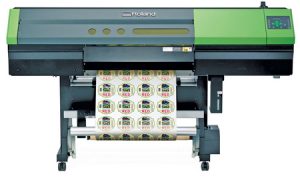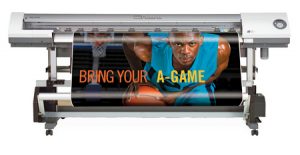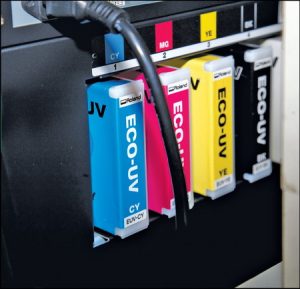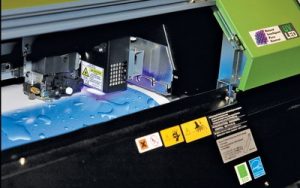Because Roland is a leading innovator, we’ve often pondered when it would enter the UV-cure printer market. We questioned if the recent cascade of UV-cure products would cause them to delay, or if it would develop something different.
Roland answered that question at the SGIA ’08 tradeshow show in Atlanta, with the introduction of its new, UV-cure printer, the VersaUV LEC-300.
Specifications
At first glance, the VersaUV LEC-300 resembles a solvent-ink printer that needs Jenny Craig. It weighs 386 lbs.; its width is 86.6 in., and the depth, 32.3 in.; it stands 49.6 in. high. Although it’s big, it’s not that big — Roland designed it to operate in a normal office environment. The LEC-300’s power requirements are 100 to 240VAC ± 10%, 50/60 Hz (maximum 3.4A), and it draws 320W, when operating.
The five-color, LEC-300 applies cyan, magenta, yellow, black and white ink ; a sixth font holds a clearcoat. The printer features Roland’s new, ECO-UV inks, available in a 220ml cartridge. Further, the LEC-300 accepts media up to .039 in. (1mm); the cutting system’s maximum media thickness is .157 in. (0.4mm).
Advertisement
Media width is up to 30 in. wide
The control panel is both sensible and easy to use. And, similar to Roland’s VersaCamm or SolJet printer/cutters, the controls features a handy, Test Cut button.
The UV-cure difference
Roland targeted the LEC-300 for a particular market, and its engineers knew a traditional UV system, or eco-solvent inks, wouldn’t do the job. The goal? A shortrun, specialty printer that offered owners more market opportunities. Therefore, the machine designers chose an LED-based, UV-cure lamp system and new inks.
Advertisement
UV-cure inks, which don’t require surface penetration, will stick to virtually anything. They also operate with low heat, compared to traditional systems. A filament-lamped, UV-cure printer’s heat may warp some media, and this limits the machine’s versatility. Oppositely, cool-operating, LED-based, curing lamps allow you to print on non-traditional media: plastic sheets, foils, leather, vinyl, metallic or porous media and much more.
White ink allows for printing on clear media and other unique graphics. The clearcoating ink is for special effects. Thus rigged, many items can be prototyped or printed with the LEC-300. Think custom signs as well as specialty markets.
The LED lamps extend the curing-lamp life up to 10,000 hours – a huge savings when compared to the lamp life seen in several market printers. Two lamps are required; one resides on each side of the printheads. The lamps don’t require shutters because the media and capping stations don’t need protection. We actually photographed the printer in action with the front cover open, something we could never do with a traditional UV printer. In addition, the lamps don’t require a warmup; thus, you can print when you power on.
The LEC-300 outputs at roughly 30 sq. ft. per hour, which is sufficient for specialty runs. It also has an integral, cutting plotter, which is icing on the cake.
The Roland twist
Advertisement
If you think you’ve heard all this before, let’s throw in a twist. The clearcoat can be layered to produce custom textures on top of the print.
You can, for example, produce faux alligator scales on a sign – or purse – for that matter. Or, create raised water droplets on a beverage label. Want Braille on a door or control panel? You can layer up to 14 “hits” of clearcoat on an image; thus, you can produce some amazing pieces. With a print resolution of 1,440 dpi, and rich, vibrant colors, the LEC-300 produces some surprising products.
The clearcoat function allows either a gloss or matte finish. Interestingly, the UV lamps are staggered, and you vary the gloss results by choosing one or both. Select the righthand lamp, only, to acquire a glossy finish (the coating flows an extra second before curing, which smoothes the surface). Select both lamps if you want a matte finish.
The new, included, VersaWorks 3 software supports all LEC-300 features.
One more thing
While we were reviewing the LEC-300, Roland demonstrated another printer we’d like to mention – the VersaArt RS series of eco-solvent printers. It’s derived from many signmakers’ desire to own a Soljet without the cost. Roland, obviously, listened and has introduced the VersaArt RS series, a related, but lower-priced, line.
Roland chose to offer high production speeds and robust construction in the VersaArt RS series, which is a printer-only device. It’s also CMYK only, compared to the Soljet’s six-color system. Also, the VersaArt doesn’t include a takeup system, although one can be installed for approximately $2,100.
Roland offers two VersaArt models – 54- and 64-in. machines. The silver-colored skins are nicely streamlined, and the control panel has a modern, rounded layout.
The media-feed system mimics the Soljet; it supports roll weights up to 66 lbs. for the 54-in. model and 88 lbs. for the 64-in. version. The printer accepts either the 220ml or 440ml Eco-Sol MAX ink cartridges.
VersaArt printers ship with the new VersaWorks 3 RIP; they also support Roland’s Intelligent Pass Control technology, which virtually eliminates banding during high-speed printing.
Speed is another plus these printers offer. It ranges from 50 sq. ft./hr. in high-quality mode to 221.7 sq. ft./hr. in billboard mode (speeds for the 64 in. model are slightly faster).
The 54-in. model sells for slightly more than $16,000, and the 64-in. version sells for less than $18,000.
Conclusion
Roland is – and always has been – on a roll. It has created a new class of specialty printer with the VersaUV LEC-300, but it didn’t forget budget-minded shops by introducing the VersaArt RS series. The LEC-300 can make signs and do some amazing tricks. (Prototyping and short-run specialties can be a lucrative business.) If you’ve longed for a Soljet, the VersaArt printers can get you most of the functionality and excellent image quality for well under $20,000.
We can’t wait to see what they come up with next.
Key Information
Roland DGA Corporation, 15363 Barranca Pkwy., Irvine, CA 92618-2216, (949) 727-2100, www.rolanddga.com.
Contact: sales@rolanddga.com
Company Profile: Founded in 1981 and listed on the Tokyo Stock Exchange, Roland DG is a leading, international provider of wide-format, inkjet printers for the durable-graphics market. In addition, Roland offers high-performance inkjet printer/cutters, precision vinyl cutters, engravers, a photo-impact printer, and a line of 3-D scanners and milling machines for applications ranging from jewelry to rapid prototyping.
At a Glance: The Roland VersaUV LEC-300, a roll-to-roll, UV-cure printer, features dual LED lamps, white ink, a clearcoat and a swivel drag knife. The VersaUV LEC-300 isn’t a “classic” UV-cure printer, because it wasn’t designed to print on rigid materials. However, it’s well suited for custom or specialty printing, including membrane-switch panels, packaging prototypes and short-run labels. The two, eco-solvent, VersaArt RS models are leaner – and less expensive – versions of Roland’s SOLJET printers. See them like buying a Corvette Z06 1LZ instead of the ZR1 3ZR.
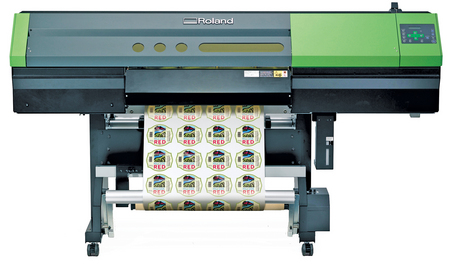


 Tip Sheet1 week ago
Tip Sheet1 week ago
 Photo Gallery1 day ago
Photo Gallery1 day ago
 Ask Signs of the Times3 days ago
Ask Signs of the Times3 days ago
 Real Deal1 week ago
Real Deal1 week ago
 Benchmarks6 days ago
Benchmarks6 days ago
 Editor's Note2 weeks ago
Editor's Note2 weeks ago
 Women in Signs1 week ago
Women in Signs1 week ago
 Photo Gallery1 week ago
Photo Gallery1 week ago